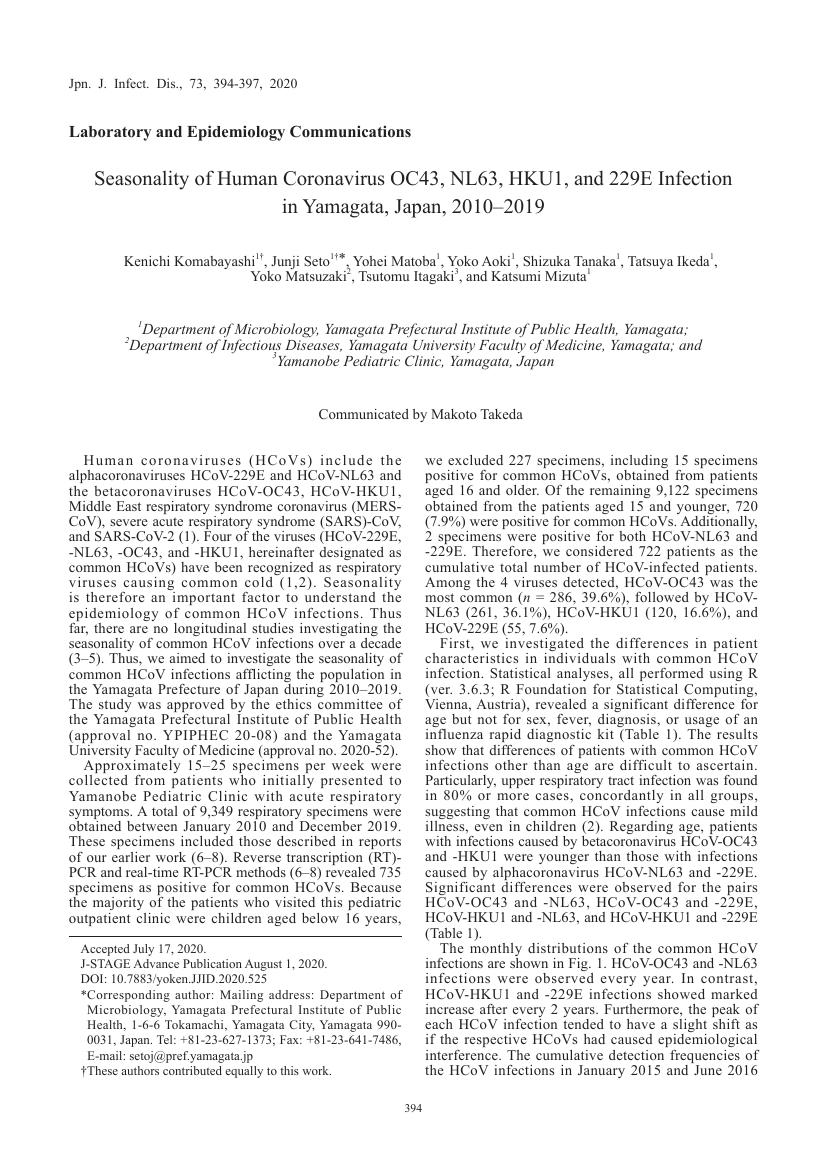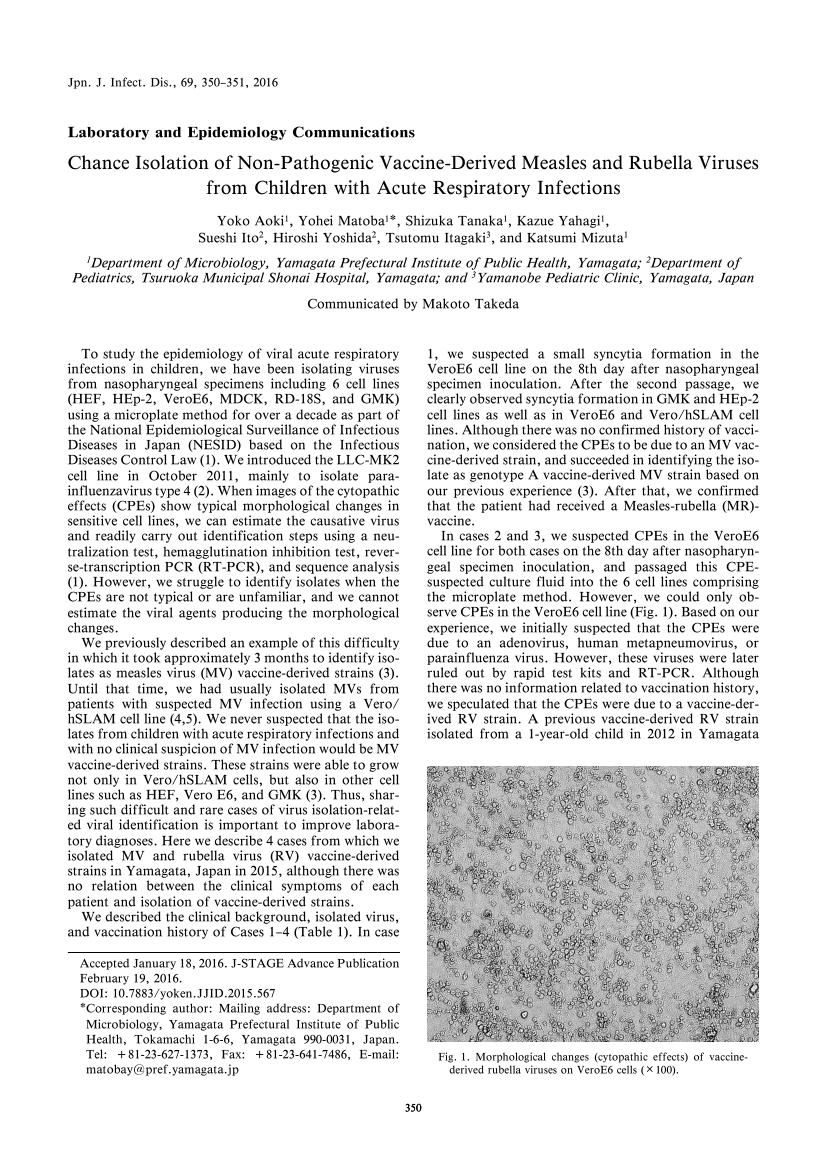49 0 0 0 OA Seasonality of human coronavirus OC43, NL63, HKU1, and 229E infection in Yamagata, Japan, 2010–2019
- 著者
- Kenichi Komabayashi Junji Seto Yohei Matoba Yoko Aoki Shizuka Tanaka Tatsuya Ikeda Yoko Matsuzaki Tsutomu Itagaki Katsumi Mizuta
- 出版者
- National Institute of Infectious Diseases, Japanese Journal of Infectious Diseases Editorial Committee
- 雑誌
- Japanese Journal of Infectious Diseases (ISSN:13446304)
- 巻号頁・発行日
- pp.JJID.2020.525, (Released:2020-08-01)
- 参考文献数
- 10
- 被引用文献数
- 1 18
- 著者
- Kenichi Komabayashi Yohei Matoba Junji Seto Yoko Ikeda Waka Tanaka Yoko Aoki Tatsuya Ikeda Yoko Matsuzaki Tsutomu Itagaki Kazuya Shirato Katsumi Mizuta
- 出版者
- National Institute of Infectious Diseases, Japanese Journal of Infectious Diseases Editorial Committee
- 雑誌
- Japanese Journal of Infectious Diseases (ISSN:13446304)
- 巻号頁・発行日
- pp.JJID.2020.776, (Released:2020-11-30)
- 参考文献数
- 31
- 被引用文献数
- 7
Isolation of seasonal coronaviruses, which include human coronavirus (HCoV) OC43, HCoV-HKU1, and HCoV-NL63, from primary cultures is difficult because it requires experienced handling, an exception being HCoV-229E, which can be isolated using cell lines such as RD-18S and HeLa-ACE2-TMPRSS2. We aimed to isolate seasonal CoVs in Yamagata, Japan to obtain infective virions useful for further research and to accelerate fundamental studies on HCoVs and SARS-CoV-2. Using modified air-liquid interface (ALI) culture of the normal human airway epithelium from earlier studies, we isolated 29 HCoVs (80.6%: 16, 6, 6, and 1 isolates of HCoV-OC43, HCoV-HKU1, HCoV-NL63, and HCoV-229E, respectively) from 36 cryopreserved nasopharyngeal specimens. In ALI cultures of HCoV-OC43 and HCoV-NL63, the harvested medium contained more than 1×104 genome copies/µL at every tested time point during the more than 100 days of culture. Four isolates of HCoV-NL63 were further subcultured and successfully propagated in an LLC-MK2 cell line. Our results suggest that ALI culture is useful for isolating seasonal CoVs and sustainably obtaining HCoV-OC43 and HCoV-NL63 virions. Furthermore, the LLC-MK2 cell line in combination with ALI cultures can be used for the large-scale culturing of HCoV-NL63. Further investigations are necessary to develop methods for culturing difficult-to-culture seasonal CoVs in cell lines.
9 0 0 0 OA Seasonality of Human Coronavirus OC43, NL63, HKU1, and 229E Infection in Yamagata, Japan, 2010–2019
- 著者
- Kenichi Komabayashi Junji Seto Yohei Matoba Yoko Aoki Shizuka Tanaka Tatsuya Ikeda Yoko Matsuzaki Tsutomu Itagaki Katsumi Mizuta
- 出版者
- National Institute of Infectious Diseases, Japanese Journal of Infectious Diseases Editorial Committee
- 雑誌
- Japanese Journal of Infectious Diseases (ISSN:13446304)
- 巻号頁・発行日
- vol.73, no.5, pp.394-397, 2020-09-30 (Released:2020-09-24)
- 参考文献数
- 10
- 被引用文献数
- 2 18
- 著者
- Yohei Matoba Yoko Aoki Shizuka Tanaka Kazue Yahagi Yuriko Katsushima Fumio Katsushima Kanetsu Sugawara Yoko Matsuzaki Katsumi Mizuta
- 出版者
- National Institute of Infectious Diseases, Japanese Journal of Infectious Diseases Editorial Committee
- 雑誌
- Japanese Journal of Infectious Diseases (ISSN:13446304)
- 巻号頁・発行日
- vol.69, no.5, pp.452-454, 2016 (Released:2016-09-21)
- 参考文献数
- 11
- 被引用文献数
- 4 15
- 著者
- Yohei Matoba Chieko Abiko Tatsuya Ikeda Yoko Aoki Yu Suzuki Kazue Yahagi Yoko Matsuzaki Tsutomu Itagaki Fumio Katsushima Yuriko Katsushima Katsumi Mizuta
- 出版者
- National Institute of Infectious Diseases, Japanese Journal of Infectious Diseases Editorial Committee
- 雑誌
- Japanese Journal of Infectious Diseases (ISSN:13446304)
- 巻号頁・発行日
- vol.68, no.2, pp.138-141, 2015 (Released:2015-03-23)
- 参考文献数
- 24
- 被引用文献数
- 40 74
The available literature on human coronaviruses (HCoVs) in Japan is limited to epidemiological studies conducted over a maximum of 1 year. We conducted a 4-year study of HCoVs by analyzing 4,342 respiratory specimens obtained in Yamagata, Japan, between January 2010 and December 2013. A pan-coronavirus reverse transcription-PCR screening assay was performed, and all HCoV-positive specimens were subsequently confirmed by sequencing of the PCR products. We detected in 332 (7.6%) HCoV strains during the study period, comprising 133 (3.1%) HCoV-NL63, 83 (1.9%) HCoV-HKU1, 78 (1.8%) HCoV-OC43, and 38 (0.9%) HCoV-229E strains. HCoV detection per year ranged from 3.5% to 9.7%. HCoVs were detected mainly in winter, with January (28.5%) and February (25.3%) 2011 and December 2012 (14.6%) being the only months in which HCoV-NL63 detection per month exceeded 10.0%. HCoV-HKU1 displayed clear biennial peaks in January (18.3%) and February (10.7%) 2010 and in February (18.8%) and March (14.7%) 2012. The peak detection of HCoV-OC43 was 13.6% in November 2010, while that of HCoV-229E was 10.8% in March 2013. Our results indicated that there may be annual variations in the circulation of individual HCoV strains. Further long-term surveillance is necessary to clarify HCoV prevalence and circulation patterns in Japan.
- 著者
- Yoko Aoki Yohei Matoba Shizuka Tanaka Kazue Yahagi Sueshi Ito Hiroshi Yoshida Tsutomu Itagaki Katsumi Mizuta
- 出版者
- 国立感染症研究所 Japanese Journal of Infectious Diseases 編集委員会
- 雑誌
- Japanese Journal of Infectious Diseases (ISSN:13446304)
- 巻号頁・発行日
- vol.69, no.4, pp.350-351, 2016 (Released:2016-07-22)
- 参考文献数
- 7
- 被引用文献数
- 5



